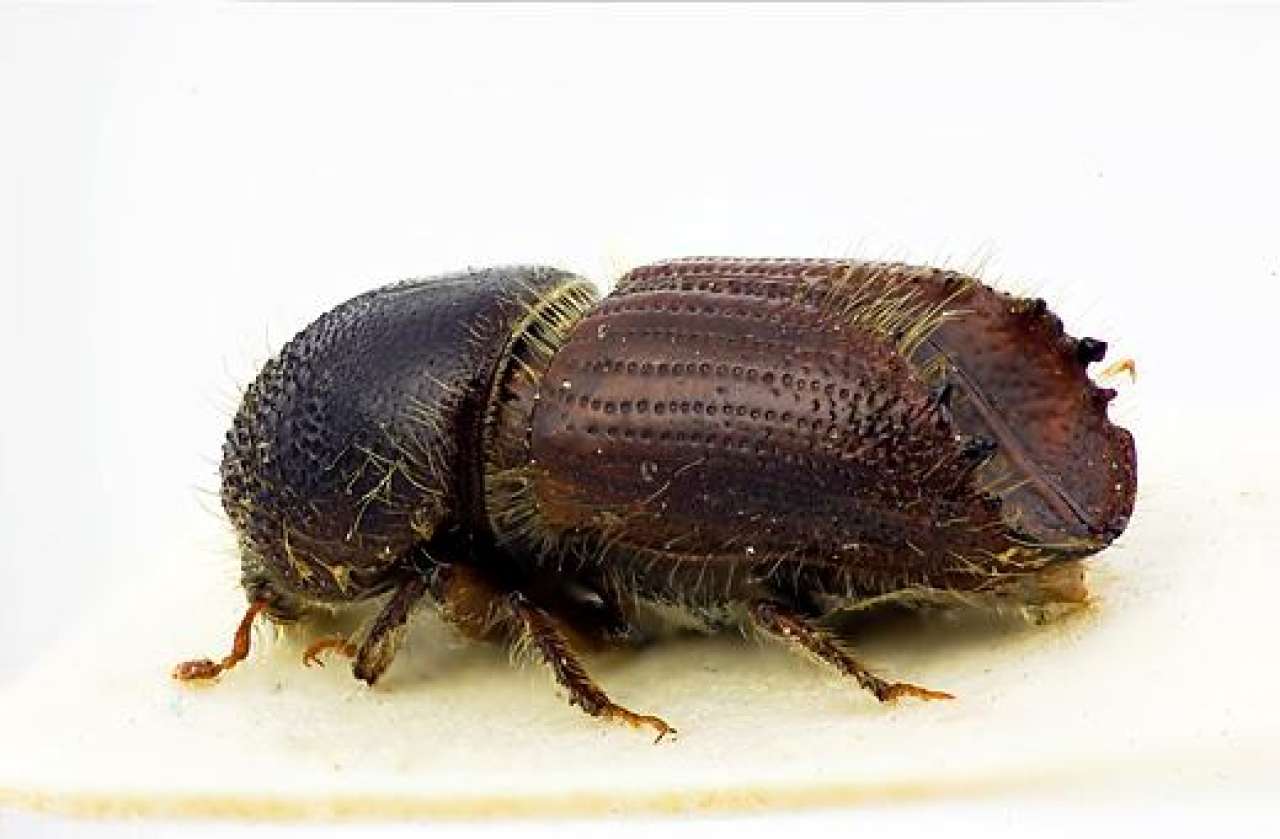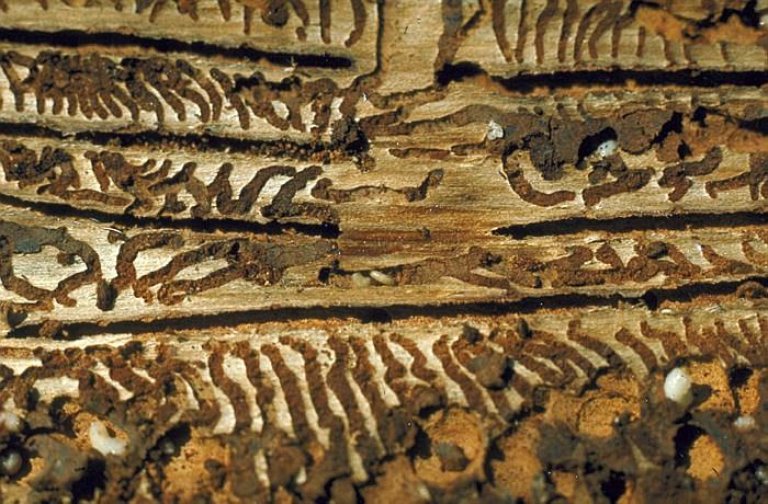Granbarkbillen

Granbarkbillen (Ips typographus) er bare 5-6 mm lang, men er det eneste insektet i Norge som kan drepe grantrær i stort omfang.
Foto: Lars S. Dalen
Granbarkbillen har drept millioner av trær i Norge og er uten tvil det viktigste skadedyret på gran i Norge og Europa forøvrig. Billene kan drepe friske trær ved å angripe i samlet flokk og overmanne trærnes forsvar.
Slike masseangrep koordineres av feromoner - duftstoffer som billene produserer og som virker tiltrekkende på andre granbarkbiller. Billene bærer også med seg blåvedsopp som hjelper billene å bryte ned treets forsvar.
Granbarkbillens livssyklus
Om våren kryper de voksne billene opp fra skogbunnen der de har tilbrakt vinteren. I normale vintre er billene godt beskyttet mot kulda av et isolerende snølag. I tillegg har billene frostvæske i blodet som gjør at de tåler ned mot 20 minusgrader. Når de kommer opp fra bakken står billene foran sitt livs tøffeste utfordring, nemlig å finne et egnet tre å bringe slekten videre i. Dette er en kritisk fase fordi billene helst angriper svekkete trær. Slike trær er vanligvis ganske sjeldne, noe som betyr at billene bruker mye krefter på å lete opp passende trær. Billene flyr vanligvis i siste halvdel av mai på Østlandet.
Når billene har funnet et egnet tre borer de seg inn i barken og lager et parringskammer. Det er alltid hannen som angriper først og begynner å produsere feromoner for å tiltrekke seg hunner. Andre hanner strømmer også til, siden lukten viser vei til et egnet vertstre. Hver hann parer seg med 2-3 hunner som så lager hver sin morgang ut fra parringskammeret. Eggene legges tett i tett langs siden av morgangen. Når eggene klekker etter en ukes tid eter larvene seg utover fra morgangen. Til sammen danner disse gangene et karakteristisk gangsystem under barken. Når larvene er ferdig utviklet forpupper de seg i barken, og ut på sensommeren kommer den nye generasjonen barkbiller ut av puppene. De holder seg vanligvis under barken til det blir kaldt i været, for så å søke ned i skogbunnen der de tilbringer vinteren. Granbarkbillen har en generasjon i året hos oss, men kan ha både to og tre generasjoner lenger syd i Europa.
Utbrudd og mottiltak
Vanligvis utnytter granbarkbillen svekkede og døende trær, slik som vindfall, ferskt tømmer eller sterkt tørkestressete trær. Men noen ganger øker billene dramatisk i antall og begynner å angripe forholdsvis friske trær. Da kan de drepe millioner av trær i utbrudd som kan vare i mange år. Sist vi hadde et omfattende utbrudd av granbarkbillen i Norge var fra starten av 1970-tallet fram til 1981. Disse årene drepte billene 5 millioner kubikkmeter gran, og i de hardest rammede kommunene ble hvert femte grantre drept.
Det beste tiltaket mot granbarkbillen er å sørge for at utbrudd ikke får anledning til å bygge seg opp. Det innebærer blant annet å sørge for at billene ikke får tilgang til store mengder vindfall, ferskt tømmer eller annet ynglemateriale. Angrepet virke bør bringes ut av skogen på forsommeren før avkommet har rukket å utvikle seg ferdig. Da forhindrer man at billene øker i antall og så angriper stående skog. Granbarkbillens feromoner ble identifisert av norske forskere på 1970-tallet og har siden blitt brukt i en årlig overvåking av granbarkbillen i Norge. Barkbilleovervåkingen kan varsle skogbrukerne når billepopulasjonene blir urovekkende store, men gir også data til forskning for å forstå den kompliserte dynamikken mellom billeantall, ynglemateriale og klimatiske faktorer.
Tjenester
Barkbilleovervåking
I samarbeid med skogbruksetaten, utfører NIBIO en årlig registrering av barkbillebestandene i Norge.
Mer informasjon Til tjenestenKONTAKTPERSON

Paal Krokene
Seniorforsker
-
Divisjon for bioteknologi og plantehelse
(+47) 995 16 013 paal.krokene@nibio.no Kontorsted: Ås - Bygg H8

Bjørn Økland
Seniorforsker
-
Divisjon for bioteknologi og plantehelse
(+47) 916 28 225 bjorn.okland@nibio.no Kontorsted: Ås - Bygg H8

KONTAKTPERSON

Paal Krokene
Seniorforsker
-
Divisjon for bioteknologi og plantehelse
(+47) 995 16 013 paal.krokene@nibio.no Kontorsted: Ås - Bygg H8

Bjørn Økland
Seniorforsker
-
Divisjon for bioteknologi og plantehelse
(+47) 916 28 225 bjorn.okland@nibio.no Kontorsted: Ås - Bygg H8
Publikasjoner
Forfattere
Lorenzo Marini Bjørn Økland Anna Maria Jönsson Barbara Bentz Allan Carroll Beat Forster Jean-Claude Grégoire Rainer Hurling Louis Michel Nageleisen Sigrid Netherer Hans Peter Ravn Aaron Weed Martin SchroederSammendrag
Bark beetles are among the most devastating biotic agents affecting forests globally and several species are expected to be favored by climate change. Given the potential interactions of insect outbreaks with other biotic and abiotic disturbances, and the potentially strong impact of changing disturbance regimes on forest resources, investigating climatic drivers of destructive bark beetle outbreaks is of paramount importance. We analyzed 17 time-series of the amount of wood damaged by Ips typographus, the most destructive pest of Norway spruce forests, collected across 8 European countries in the last three decades. We aimed to quantify the relative importance of key climate drivers in explaining timber loss dynamics, also testing for possible synergistic effects. Local outbreaks shared the same drivers, including increasing summer rainfall deficit and warm temperatures. Large availability of storm-felled trees in the previous year was also strongly related to an increase in timber loss, likely by providing an alternative source of breeding material. We did not find any positive synergy among outbreak drivers. On the contrary, the occurrence of large storms reduced the positive effect of warming temperatures and rainfall deficit. The large surplus of breeding material likely boosted I. typographus population size above the density threshold required to colonize and kill healthy trees irrespective of other climate triggers. Importantly, we found strong negative density dependence in I. typographus that may provide a mechanism for population decline after population eruptions. Generality in the effects of complex climatic events across different geographical areas suggests that the large-scale drivers can be used as early warning indicators of increasing local outbreak probability.
Sammendrag
The purpose of this study is to increase the basic understanding of outbreak dynamics in order to improve the management of bark beetle outbreaks. The spruce bark beetle Ips typographus is a major disturbance agent of European forests and is the continent’s most economically and environmentally damaging bark beetle. Outbreaks of the spruce bark beetle are often triggered by large windfall episodes, and we have utilized a unique opportunity to study a Slovakian outbreak where little salvage logging was performed in some areas after a 2.5 million m3 storm-felling in 2004. Our analyses focused on the first five years after the windfall, and we used a combination of empirical data and simulation models to understand the spatial patterns of beetle-killed forest patches developing during the outbreak. The univoltine beetle population used an increasing proportion of the windfelled trees during the two first seasons after the storm, but from the third season onwards our comparisons of inter-patch distance distributions indicated a transition from beetle production largely in windfall areas to a self-sustaining outbreak with infestation patches developing independently of the windthrows. The size of new infestation patches formed after this transition was modeled as a function of beetle pressure, estimated by the proportion of a circle area surrounding new patches that was covered by infestation patches the previous year. Our model results of patch size distribution did not correspond well with the empirical data if patch formation was modeled as a pure dispersal–diffusion process. However, beetle aggregation on individual trees appears to be important for patch development, since good correspondence with empirical data was found when beetle aggregation was incorporated in the modeled dispersal process. The strength of correspondence between the beetle aggregation model and the empirical data varied with the density of aggregation trees in the modeled landscape, and reached a maximum of 83% for a density of three aggregation trees per infestation patch. Our results suggest that efficient removal of windfelled trees up until the start of the second summer after a major windfall is important to avoid a transition into a patch-driven bark beetle outbreak that is very difficult to manage. Our results also indicate that the outcome of a patch-driven outbreak is difficult to predict, since the development of new infestation patches is not a simple function of beetle pressure but is also affected by beetle behavior and local forest conditions.
Sammendrag
Det er ikke registrert sammendrag
Forfattere
Kyrre Linné Kausrud Bjørn Økland Olav Skarpaas Jean-Claude Grégoire Nadir Erbilgin Nils Christian StensethSammendrag
In recent decades we have seen rapid and co-occurring changes in landscape structure, species distributions and even climate as consequences of human activity. Such changes affect the dynamics of the interaction between major forest pest species, such as bark beetles (Coleoptera: Curculionidae, Scolytinae), and their host trees. Normally breeding mostly in broken or severely stressed spruce; at high population densities some bark beetle species can colonise and kill healthy trees on scales ranging from single trees in a stand to multi-annual landscape-wide outbreaks. In Eurasia, the largest outbreaks are caused by the spruce bark beetle, Ips typographus (Linnaeus), which is common and shares a wide distribution with its main host, Norway spruce (Picea abies Karst.). A large literature is now available, from which this review aims to synthesize research relevant for the population dynamics of I. typographus and co-occurring species under changing conditions. We find that spruce bark beetle population dynamics tend to be metastable, but that mixed-species and age-heterogeneous forests with good site-matching tend to be less susceptible to large-scale outbreaks. While large accumulations of logs should be removed and/or debarked before the next swarming period, intensive removal of all coarse dead wood may be counterproductive, as it reduces the diversity of predators that in some areas may play a role in keeping I. typographus populations below the outbreak threshold, and sanitary logging frequently causes edge effects and root damage, reducing the resistance of remaining trees. It is very hard to predict the outcome of interspecific interactions due to invading beetle species or I. typographus establishing outside its current range, as they can be of varying sign and strength and may fluctuate depending on environmental factors and population phase. Most research indicates that beetle outbreaks will increase in frequency and magnitude as temperature, wind speed and precipitation variability increases, and that mitigating forestry practices should be adopted as soon as possible considering the time lags involved.
Forfattere
Anna Maria Jönsson Susanne Harding Paal Krokene Holger Lange Åke Lindelöw Bjørn Økland Hans Peter Ravn Leif Martin SchroederSammendrag
The Eurasian spruce bark beetle, Ips typographus, is one of the major forest insect pests in Europe, capable of mass-attacking and killing mature Norway spruce trees. The initiation and development of a new generation are strongly controlled by temperature and a warmer climate may affect the number of generations that is produced per year and hence the outbreak dynamics. Experimental knowledge regarding reproductive diapause adaptations is, however, too sparse for largescale assessments of future trends. We developed a model description of diapause induction, and used gridded observational temperature data to evaluate multiple combinations of day length and temperature thresholds to find the model parameterisation most coherent with I. typographus monitoring data from Scandinavia. The selected model parameterisation is supported by European literature data, though further experimental studies are required to analyse population specific adaptations and capacity for adjustments to changing climate conditions. Implementing the model description of reproductive diapause in a temperature driven model of bark beetle phenology (swarming activity and development from egg to mature bark beetle), enabled us to assess the length of the late summer swarming period that is a critical determinant of the risk of forest damage. By using regional climate model data we show that higher temperatures can result in increased frequency and length of late summer swarming events, producing a second generation in southern Scandinavia and a third generation in lowland parts of central Europe. Reproductive diapause will not prevent the occurrence of an additional generation per year, but the day length cues may restrict the length of the late summer swarming period.
Sammendrag
Det er ikke registrert sammendrag
Sammendrag
Detailed analyses of thresholded ecological interactions can improve our understanding of the transition from aperiodic to periodic dynamics. We develop a threshold model of the population dynamics of outbreaking bark beetle populations that alternate between non-epidemic and epidemic behavior. The model involves accumulation of resources during low-density periods and depletion during outbreaks. The transition between the two regimes is caused by disturbance events in the form of major tree felling by wind. The model is analyzed with particular reference to the population dynamics of the spruce bark beetle (Ips typographus) in Scandinavia for which a comprehensive literature allows full parameterization. The fairly constant outbreak lengths and the highly variable waiting time between outbreaks that are seen in the historical records of this species agree well with the predictions of the model. The thresholded resource-depletion dynamics result in substantial variation in the degree of periodicity between stochastic realizations. The completely aperiodic tree colonizations are partly predictable when the timing of the irregular windfall events are known. However, the predictability of inter-outbreak periods is low due to the large variation of cases falling most frequently in the middle between the extremes of purely nonperiodic (erratic) and periodic (cyclic) fluctuations.
Sammendrag
Det er ikke registrert sammendrag
